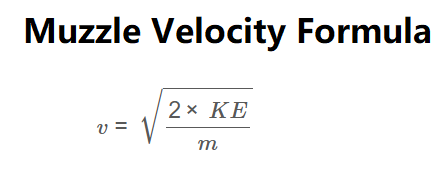1. What is a Muzzle Velocity Calculator?
Definition: This calculator determines the muzzle velocity of a bullet using one of three methods: kinetic energy, barrel pressure, or distance and time.
Purpose: It is used in ballistics to estimate the speed of a bullet as it exits a firearm, aiding in understanding firearm performance and bullet trajectory.
2. How Does the Calculator Work?
The calculator supports three methods to calculate muzzle velocity:
Using Kinetic Energy:
\[
v = \sqrt{\frac{2 \times KE}{m}}
\]
Using Barrel Pressure:
\[
v = \sqrt{\frac{2 \times P \times A \times L}{m}}, \quad \text{where} \quad A = \pi \left(\frac{D}{2}\right)^2
\]
Using Distance and Time:
\[
v = \frac{d}{t}
\]
Where:
- \( v \): Muzzle velocity (m/s, km/h, ft/s, mph, kn, ft/min)
- \( KE \): Bullet kinetic energy (J, kJ, MJ, Wh, kWh, ft-lb, kcal)
- \( P \): Average pressure (Pa, kPa, MPa, bar, psi)
- \( A \): Cross-sectional area of the bore (m²)
- \( D \): Bore diameter (mm, cm, in)
- \( L \): Barrel length (cm, m, in, ft, yd)
- \( d \): Distance (cm, m, in, ft, yd, km, mi)
- \( t \): Time (sec, min, hrs)
- \( m \): Bullet mass (mg, g, kg, oz, lb)
Unit Conversions:
- Mass Units (m): mg, g, kg, oz, lb
- Energy Units (KE): J, kJ, MJ, Wh, kWh, ft-lb, kcal
- Pressure Units (P): Pa, kPa, MPa, bar, psi
- Diameter Units (D): mm, cm, in
- Length Units (L, d): cm, m, in, ft, yd, km, mi
- Time Units (t): sec, min, hrs
- Velocity Units (v): m/s, km/h, ft/s, mph, kn, ft/min
Steps:
- Select the calculation method (Kinetic Energy, Barrel Pressure, or Distance and Time)
- Enter the bullet mass (m), selecting the unit
- Enter the method-specific inputs, selecting the appropriate units
- Convert all inputs to SI units (kg, J, Pa, m, sec)
- Calculate the muzzle velocity using the selected method
- Select the desired unit for the muzzle velocity and view the result
3. Importance of Muzzle Velocity Calculation
Calculating muzzle velocity is crucial for:
- Ballistics: Understanding the initial speed of a bullet to predict its trajectory and impact.
- Firearm Design: Optimizing barrel length, pressure, and bullet mass for desired performance.
- Safety and Accuracy: Ensuring accurate shooting by accounting for bullet speed in various conditions.
4. Using the Calculator
Examples:
- Example 1 (Kinetic Energy): Bullet mass \( m = 10 \, \text{g} \), kinetic energy \( KE = 500 \, \text{J} \):
- Mass in kg = \( 10 \times 0.001 = 0.01 \, \text{kg} \)
- Muzzle velocity = \( \sqrt{\frac{2 \times 500}{0.01}} = \sqrt{100000} = 316.228 \, \text{m/s} \)
- Example 2 (Barrel Pressure): Bullet mass \( m = 5 \, \text{g} \), pressure \( P = 300 \, \text{MPa} \), bore diameter \( D = 9 \, \text{mm} \), barrel length \( L = 50 \, \text{cm} \):
- Mass in kg = \( 5 \times 0.001 = 0.005 \, \text{kg} \)
- Pressure in Pa = \( 300 \times 1000000 = 300000000 \, \text{Pa} \)
- Bore diameter in m = \( 9 \times 0.001 = 0.009 \, \text{m} \)
- Cross-sectional area = \( \pi \times \left(\frac{0.009}{2}\right)^2 = 6.362 \times 10^{-5} \, \text{m}^2 \)
- Barrel length in m = \( 50 \times 0.01 = 0.5 \, \text{m} \)
- Muzzle velocity = \( \sqrt{\frac{2 \times 300000000 \times 6.362 \times 10^{-5} \times 0.5}{0.005}} = \sqrt{3817200} = 1953.763 \, \text{m/s} \)
- Example 3 (Distance and Time): Distance \( d = 100 \, \text{m} \), time \( t = 0.2 \, \text{sec} \), mass not used:
- Muzzle velocity = \( \frac{100}{0.2} = 500.000 \, \text{m/s} \)
5. Frequently Asked Questions (FAQ)
Q: What is muzzle velocity?
A: Muzzle velocity (\( v \)) is the speed of a bullet as it exits the barrel of a firearm, typically measured in meters per second (m/s).
Q: Why use different methods to calculate muzzle velocity?
A: Different methods allow flexibility based on available data: kinetic energy for energy-based measurements, barrel pressure for firearm design, and distance/time for field measurements.
Q: Why is the distance/time method less accurate?
A: The distance/time method gives the average velocity over the distance, which is lower than the muzzle velocity due to air resistance slowing the bullet.
Muzzle Velocity Calculator© - All Rights Reserved 2025
 Home
Home
 Back
Back
